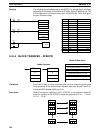
188
Description When the execution condition is OFF, MOVB(82) is not executed. When the
execution condition is ON, MOVB(82) copies the specified bit of S to the speci-
fied bit in D. The bits in S and D are specified by Bi. The rightmost two digits of Bi
designate the source bit; the leftmost two bits designate the destination bit.
1
Bi
120
Source bit (00 to 15)
Destination bit (00 to 15)
0 0 0 1 001000000001
Bit
15
Bit
00
0101010001110001
0100010001110001
S
D
Bi
1201
Bit
15
Bit
15
Bit
00
Bit
00
LSBMSB
Flags ER: C is not BCD, or it is specifying a non-existent bit (i.e., bit specification
must be between 00 and 15).
Indirectly addressed DM word is non-existent. (Content of DM word is
not BCD, or the DM area boundary has been exceeded.)
N: ON if the leftmost bit of the content of word D is 1, otherwise OFF.
5-16-9 MOVE DIGIT – MOVD(83)
S: Source word
IR, SR, AR, DM, HR, TC, LR, #
Di: Digit designator (BCD)
IR, SR, AR, DM, HR, TC, LR, #
Ladder Symbols
Operand Data Areas
D: Destination word
IR, SR, AR, DM, HR, TC, LR
MOVD(83)
S
Di
D
@MOVD(83)
S
Di
D
Limitations The rightmost three digits of Di must each be between 0 and 3.
Description When the execution condition is OFF, MOVD(83) is not executed. When the
execution condition is ON, MOVD(83) copies the content of the specified digit(s)
in S to the specified digit(s) in D. Up to four digits can be transferred at one time.
The first digit to be copied, the number of digits to be copied, and the first digit to
receive the copy are designated in Di as shown below. Digits from S will be co-
pied to consecutive digits in D starting from the designated first digit and contin-
ued for the designated number of digits. If the last digit is reached in either S or D,
further digits are used starting back at digit 0.
First digit in S (0 to 3)
Number of digits (0 to 3)
0: 1 digit
1: 2 digits
2: 3 digits
3: 4 digits
First digit in D (0 to 3)
Not used.
Digit number: 3210
Data Movement Section 5-16


















